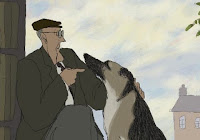Paul Fierlinger has been animating film for over half a century (he was an original animator on "Sesame Street" in 1969), but this is the first feature film that he and his wife Sandra have completed. It is a faithful adaption of J.R. Ackerley’s memoir of his life in the company of a beloved German Shepherd, Queenie, in London in the ‘40s and ‘50s (publishers changed the name of the dog over concern that the dog’s real name would lead to people mocking the author’s homosexuality).
Despite the subject matter and playful visual style, I would be hard pressed to say that the film is truly family fare. It devotes a great deal of time to the more earthy concerns of dog ownership (I speak of defecation, urination and copulation). But to make a film about one’s relationship with a pet without covering these matters would be dishonest, and in detailing how Ackerley deals with these things, you ultimately appreciate his unconditional love for the dog: He gets from Queenie/Tulip what he never managed to find in human companionship. From the memoir -- “She offered me what I had never found in my life with humans: constant, single-hearted, incorruptible, uncritical devotion, which it is in the nature of dogs to offer.” Whether or not this is something we should want or expect from another human being is a question not raised, sadly.
You would hardly be blamed for assuming that My Dog Tulip is a lovingly hand-crafted animated film steeped in traditions rendered extinct in the wake of digital technology. It has the look of detailed book illustrations. There’s little effort expended trying to make motion seem fluid or realistic -- objects appear to be pushed across the screen by an unseen hand. Most dialogue is spoken in voice-over (primarily by Christopher Plummer, with smaller roles played by Isabella Rossellini and the late Lynn Redgrave) and not tied to mouth movement. And, frequently, the water color imagery gives way to simple pencil drawings as if they were pages torn out of an illustrator’s sketch book. Lovingly hand-crafted it may appear, but the reality is that the film was made utilizing the same advanced technology to which it would seem to exist in defiant opposition. The filmmakers drew every frame at their home (in Wynnewood, PA) using a digital pen and a computer tablet over the course of two-and-a-half years. The film includes a credit explaining that not a single piece of paper was used during its creation. I found this declaration almost as charming as the film itself, a clear-eyed, adult look at a relationship rarely explored so honestly on the screen.

No comments:
Post a Comment